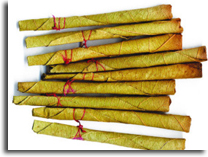 News-reports suggest that the government is planning to ban the sale of loose cigarettes. Sagarika Mukherjee an analyst with SBI Caps points out that 70% of the cigarettes sold in India are sold loose.
News-reports suggest that the government is planning to ban the sale of loose cigarettes. Sagarika Mukherjee an analyst with SBI Caps points out that 70% of the cigarettes sold in India are sold loose.
Further, a November 26 news-eport in the Mumbai Mirror says “The union health ministry on Tuesday recommended a ban on the sale of unpackaged cigarettes to deter smokers from graduating to buying full packs.”
The health minister JP Nadda said in the Rajya Sabha on November 25 that the ministry had accepted the recommendations of a seven member committee on the “prohibition on sale of loose or single stick of cigarette, increasing the minimum legal age for sale of tobacco products, increasing the fine or penalty amounts for violation of certain provisions of the Act as well as making such offences cognizable”.
On the face of it this seems to be a good decision. We all know that cigarette smoking is injurious to health. Nevertheless, before the sale of loose cigarettes is actually banned there are several other points that need to be taken into account.
Governments normally tend to see what is only immediately obvious and ignore the secondary consequences. The economist Henry Hazlitt calls this the broken window fallacy. He explains this through an example in his book Economics in One Lesson.
A young hoodlum throws a stone at a shop’s window and breaks it. By the time the shopkeeper realises what has happened and comes out of the shop, the boy has already escaped. As often happens in these cases, a crowd gathers around, first trying to figure out what has happened and then offers its own analysis on the scenario. In sometime, the crowd decides rather philosophically that what happened was for the good.
As Hazlitt writes “After a while the crowd feels the need for philosophic reflection…It will make business for some glazier….After all, if windows were never broken, what would happen to the glass business?”
With the shopkeeper now having to repair the window, the glazier would earn more money. He would thus have more money to spend and would spend it in the days to come. And this would benefit other businessmen. “The smashed window will go on providing money and employment in ever-widening circles. The logical conclusion from all this would be…that the little hoodlum who threw the stone, far from being a public menace, was a public benefactor,” writes Hazlitt.
All this sounds very straightforward. But what it does not take into account is the fact that the shopkeeper would have to spend money in order to get the window repaired. And he may have earmarked to spend the money on something else.
In Hazlitt’s example, the shopkeeper wanted to buy a suit. Now that he has to spend money on getting the window repaired, he would have no money to buy a suit. As Hazlitt writes “The people in the crowd were thinking only of two parties to the transaction, [the shopkeeper] and the glazer. They had forgotten the potential third party involved, the tailor [who would have made the suit]. They forgot him precisely because he will not now enter the scene. They will see the new window in the next day or two. They will never see the extra suit, precisely because it will never be made. They see only what is immediately visible to the eye…It is the fallacy of overlooking secondary consequences.”
Many government decisions are plagued with the fallacy of overlooking secondary consequences. The recommendation to ban the sale of loose cigarettes also overlooks several secondary consequences. Also, it stinks of hypocrisy and is the kind of micromanaging which governments should be avoiding.
Typically, most people who buy loose cigarettes are ones who cannot afford to buy a packet at one go. If loose cigarettes are banned will these people stop smoking? Most likely not. They will either save up and buy a packet every few days.
Or they will simply move on to a cheaper substitute, which in this case would be beedis. Beedis because they do not have a filter are a bigger health hazard than cigarettes with filters are. And chances are the government will end up spending more money in trying to cure tobacco related illnesses, in the years to come.
Further, the question is how will the government implement such a ban? Cigarettes aren’t exactly sold through a few big stores around the country which can be monitored. They are sold by millions of paan wallahs through the length and the breadth of the country. Mukherjee of SBI Caps puts the number of shops selling cigarettes from anywhere between seven to eight million.
I used to live in Hyderabad in the early 2000s, when the erstwhile Andhra Pradesh government decided to ban gutka. All that happened was that the paan wallahs stopped displaying gutka packets in the open and started keeping them in their pockets.
Further, they even demanded a premium to the maximum retail price. The police was suitably bribed to look the other way. Gutka which was freely available in states around Andhra Pradesh continued to be smuggled in.
Another logic offered in support of not allowing the sale of single sticks is that when a packet is sold, it contains graphic images showing the ill-effects of smoking. When loose cigarettes are sold, individuals buying those cigarettes don’t see those graphic images. Hence, sale of loose cigarettes should not be allowed.
Other countries in Asia have banned the sale of loose cigarettes using the logic explained above. So, the cigarette companies there simply moved to producing smaller packets. The committee whose recommendations the health ministry has accepted has already recommended that smaller packets should not be allowed. But this is where you start to discriminate between those who can afford to buy a cigarette pack and those who can’t.
Mukherjee of SBI Caps points out that only 12% of the tobacco consumption in the country happens through cigarettes. And cigarette companies contribute a major portion of the excise duty and other taxes collected from the tobacco industry. So, if the government is serious about tackling tobacco consumption why not look where the real problem is? Attacking the beedi sector will be a difficult thing to do, given that the beedi barons are politically very well connected.
Another thing that needs to be pointed out here is that the government of India owns around one third of ITC, a company which controls 80% of the Indian tobacco market. The Life Insurance Corporation of India owns 14.5% stake, followed by the Specified Undertaking of the Unit Trust of India (SU-UTII) which owns 11.25% and the four general insurance companies together own 6.78% in the tobacco major.
This stake of LIC, SU-UTI and the four general insurance companies, in ITC, as on November 26, 2014, was worth a whopping Rs 94,241 crore. The actual stake of the government will be worth much more once one takes into account the holdings of government owned mutual funds as well.
If the government is serious about discouraging tobacco consumption, the first thing it needs to do is sell its stake in ITC and then take it on from there. This money could be put to good use by helping specialized cancer hospitals in the country to expand their infrastructure or to even set up new ones. Then there is also the case of the government subsidizing fertilizers, a portion of which goes into tobacco farming as well.
The beedi industry does not face the same kind of taxes that the cigarette industry does. Why not do away with that anomaly? In a recent column Swaminathan Aiyar talks about a column he wrote in 2009. At that point time Indians consumed around one trillion beedis per year against 106 billion cigarettes. If the taxes on beedis and nonfilter cigarettes were equalized it would have yielded an additional revenue of Rs 15,000 crore per year, back then. If taxes on beedis were equalised to the level of tax on a standard filter cigarette, it would have yielded an additional tax of Rs 80,000 crore per year. If such a tax is implemented now, the numbers will be higher.
What all this clearly tells us is that targeting just loose cigarettes doesn’t make any sense. If tobacco consumption is to be brought down, it needs a more holistic solution than what is being currently offered. The current government like most governments before it has fallen victim to the broken window fallacy.
Disclosure: I do not smoke. And I would like to thank PV Subramanyan for explaining several points that I made in this piece.
The article appeared originally on www.equitymaster.com on Nov 27, 2014

